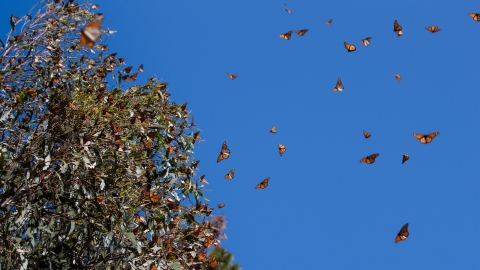It’s early November, which means the monarch butterfly migration is finally coming to an end. The lucky butterflies east of the Rocky Mountains – who have beaten all odds to survive predators, parasites, storms, and a 3,000- mile flight – are ready to rest for the winter months in the transvolcanic mountains of Mexico.
During winter, the normally solitary monarchs roost in large groups to stay warm and maintain fat reserves they’ve accumulated from the fall, clinging tightly to each other in oyamel fir forests. These tiny, dwindling stands of trees provide a microclimate with an ideal temperature, humidity, and elevation for monarchs to safely overwinter. On brief, sunny occasions, monarchs will venture off in search of water, never straying too far from the protective cover of the trees.
Monarch populations are most easily monitored during the winter months when most of their population are found in the same location. While breeding populations in late summer are much larger, many monarchs don’t survive the migration and therefore do not contribute to the next spring’s generation. NatureServe and The Xerces Society for Invertebrate Conservation estimate monarchs occupy less than three hectares of oyamel fir forests across 12 different locations, a sharp decline from the 50-acre stand used by wintering monarchs in the late 1990s.
If this fascinating journey and tale of survival wasn’t interesting enough, the arrival of the monarch migration in Mexico coincides with a significant event in Mexican culture. November 1 and 2 marks the celebration of “El Dia de los Muertos” or Day of the Dead, a time when everyone comes together to celebrate and remember deceased family, friends, and ancestors. While traditions may vary in celebrations, to many the return of the monarch symbolizes the souls of the dead returning to visit each year.
Monarchs arriving at the wintering grounds in Mexico are the “great grandchildren” of the monarchs that began the migration cycle in spring. While the earlier generations can live for several weeks, the fourth (or sometimes fifth) generation of super monarchs can survive upwards of nine months, covering up to 3,000 miles and surviving the winter months in Mexico before kicking off the spring migration next year.
Monarch populations have dropped significantly in the last 20 years. Harsh weather events and loss of summer breeding habitat contribute to declining numbers. Illegal logging and invasive species invasive species
An invasive species is any plant or animal that has spread or been introduced into a new area where they are, or could, cause harm to the environment, economy, or human, animal, or plant health. Their unwelcome presence can destroy ecosystems and cost millions of dollars.
Learn more about invasive species have resulted in fragmentation of the integrity of the oyamel forests in which the monarchs overwinter. We can help monarchs and other pollinating insects by creating pollinator gardens and beneficial habitat they can use throughout the year.





